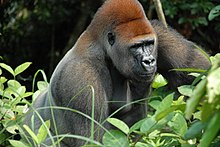
Burundi Post issued the stamp series feature monkey species on March 15, 2011. The issues are consist of three single postage stamps and one gorillas-shaped souvenir sheet.
The uncontrolled cutting of trees for fuel-wood, coupled with agricultural clearing and grazing lands has resulted in nearly complete deforestation of this country . The serious loss of land has effected wildlife severely.
Widespread ethnic civil war and the subsequent collapse of government conservation efforts further reduced forest areas and resulted in increased poaching of wildlife.
Due to habitat destruction, gorillas and elephants are extinct in Burundi and virtually all wildlife is threatened.


Chimpanze
The common chimpanzee is covered in course black hair but has a bare face, fingers, toes, palms of the hands and soles of the feet. The common chimpanzee, often called the chimpanzee, is a species of great ape and listed on the IUCN Red List as an endangered species.There are between 170,000 and 300,000 individuals across its range in the forests and savannahs of West and Central Africa. The biggest threats to the common chimpanzee are habitat destruction, poaching and disease.
The common chimpanzee lives in groups which range in size from 15 to 150 members, although individuals travel and forage in much smaller groups during the day. The species lives in a male-dominated, strict hierarchy, which means disputes can generally be settled without the need for violence. Chimpanzees use a variety of facial expressions, postures and sounds to communicate with each other.
Nearly all chimpanzee populations have been recorded using tools. They will modify sticks, rocks, grass, and leaves and use them when foraging for honey, termites, ants, nuts, and water.
The common chimpanzee is a highly adaptable species. It lives in a variety of habitats, including: dry savanna, evergreen rainforest, montane forest, swamp forest, and dry woodland-savanna mosaic.


Baboon
Baboons are African and Arabian Old World monkeys belonging to the genus Papio, part of the subfamily Cercopithecinae. All baboons have long dog-like muzzles; heavy, powerful jaws with sharp canine teeth; close-set eyes; thick fur except on their muzzle; a short tail; and rough spots on their protruding buttocks, called ischial callosities.
Baboons are terrestrial (ground dwelling) and are found in open savannah, open woodland and hills across Africa. Their diet is omnivorous, but mostly herbivorous; yet they eat insects and occasionally prey on fish, shellfish, hares, birds, and small antelopes.Their principal predators are humans, the lion, both the spotted and striped hyena and the leopard.
Baboons in captivity have been known to live up to 45 years, while in the wild their life expectancy is about 30 years.Most baboons live in hierarchical troops. Group sizes vary between 5 to 250 animals (often about 50 or so), depending on specific circumstances, especially species and time of year.


Gorillas are the largest extant species of primates. They are ground-dwelling, predominantly herbivorous apes that inhabit the forests of central Africa. Gorillas live in groups called troops. Troops tend to be made of one adult male or silverback, multiple adult females and their offspring.
The silverback is the center of the troop's attention, making all the decisions, mediating conflicts, determining the movements of the group, leading the others to feeding sites and taking responsibility for the safety and well-being of the troop
Females mature at 10–12 years (earlier in captivity); males at 11–13 years.A gorilla's lifespan is between 35–40 years, although zoo gorillas may live for 50 years and more. Gorilla is listed as critically endangered on the Red List of IUCN.
The DNA of gorillas is highly similar to that of a human, from 95–99% depending on what is counted,and they are the next closest living relatives to humans after the bonobo and chimpanzee.

No comments:
Post a Comment